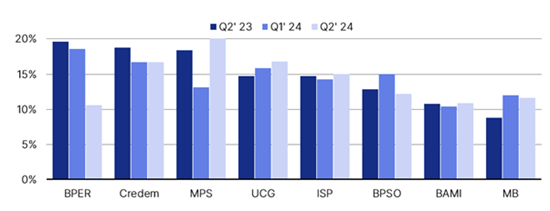Announcements
Drinks

Italian bank quarterly: Higher-for-longer rates support performance, credit fundamentals improve
Latest earnings were driven by higher-than-expected rates, higher fees, controlled costs and contained provisions. Our sample of eight Italian banks (Intesa Sanpaolo, UniCredit, Banco BPM, Banca Monte dei Paschi di Siena, BPER Banca, Mediobanca, Credito Emiliano and Banca Popolare di Sondrio) achieved a return on average equity of 15.6% in the second quarter, up from 14.5% in Q1 2024 and 14.8% in Q2 2023
Italian banks’ return on equity

Source: SNL, Scope Ratings. Note: based on statutory net income. Calendar years
Note: MPS’s ROE in Q2 2024 was 31.3% thanks to a positive tax effect of EUR 457m
“Interest rates have not declined rapidly, as doubts about persistent inflationary pressures have led the ECB to maintain a relatively tight monetary policy. And while Italian banks' assets have gradually repriced at higher rates, remuneration on customer deposits has been muted, reflecting the captive nature of most current accounts in Italy” said Alessandro Boratti, Scope’s lead analyst for Italian banks.
Net interest income remained close to the peak of Q4 2023 while fees and commissions grew for the second consecutive quarter. Average assets under management and custody grew by 1.5% and 1.3%. Commercial banking revenues also rose, reflecting higher pricing and payments revenues. Italian banks remain focused on increasing revenues from complementary financial services, one of the few growth opportunities in a mature banking market.
Operating costs continued to trend modestly higher, driven by higher personnel costs and growing business-related expenses and investments in digital innovation. The average cost-income ratio increased to 45.8% in Q2 2024, from 44.2% in Q2 2023. Capital positions are solid, allowing the banks to increase distributions while funding positions are comfortable, despite TLTRO III repayments. Our sample of Italian banks reported quarterly growth in deposits.
“We remain constructive about the sector’s profitability although there are potential downside risks. The economic backdrop remains highly uncertain, further volatility in financial markets is possible, and the government is mulling over a measure to force banks to raise rates on current accounts,” Boratti said. “And while asset quality remains strong, we are starting to see a small pick-up in default rates.” Average cost of risk remained broadly stable, at 36bp.
Scope expects asset quality to gradually worsen as the impact of higher interest payments starts to affect the most vulnerable borrowers. But banks are well prepared for this as they have all budgeted for higher default rates compared to 2023 while projecting a stable annual cost of risk thanks to pre-emptive provisioning, high coverage, and state-guarantees on certain positions.
“At current profitability levels, we estimate that Italian banks generate around 70bp-90bp of pre-distribution capital each quarter, more than double the 2021-22 period. This supports higher shareholder remuneration,” Boratti said.
Download the Italian bank quarterly here.
Scope has public ratings on the following Italian banks:
Scope has subscription ratings on the following Italian banks. To view the ratings and rating reports on ScopeOne, Scope’s digital marketplace, or to register, please click on the following links:
Stay up to date with Scope’s ratings and research by signing up to our newsletters across credit, ESG and funds. Click here to register.





